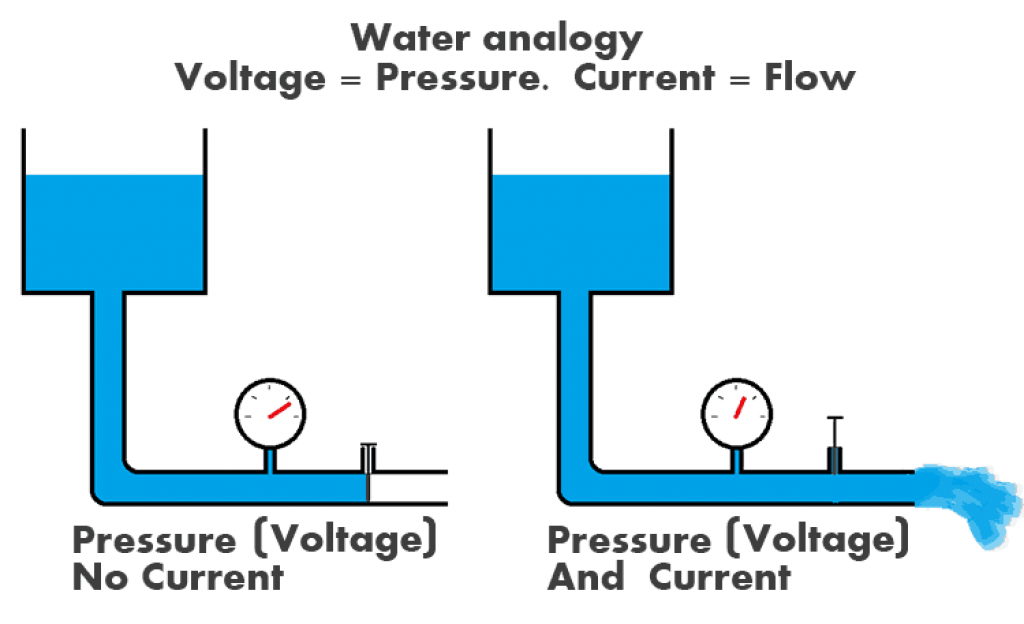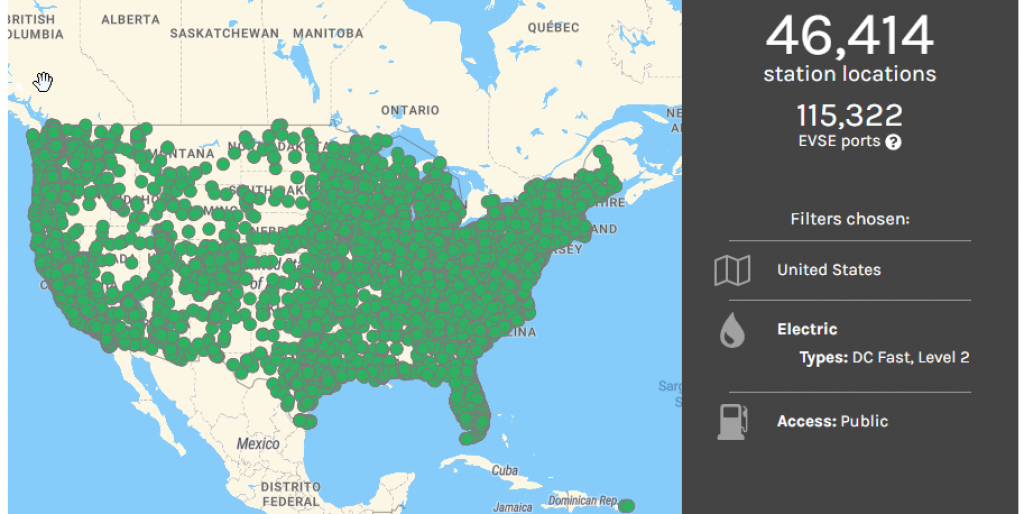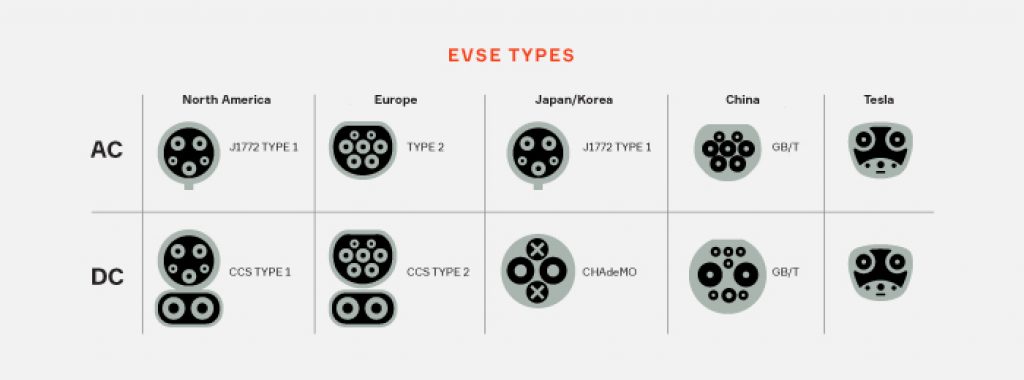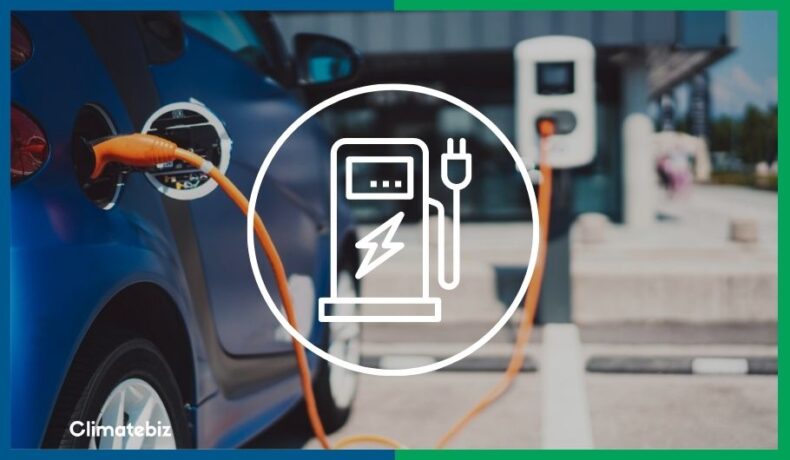Knowing how long it takes to charge an EV is straightforward if you’re confident with the fundamentals of electrical engineering.
We’re talking about being comfortable with basic electrical engineering terms when determining the charging time: watts, kWh, volts, and amps.
Why even bother knowing these things?
Let’s show you why using an old analogy will help you become acquainted with these concepts.
Table of Contents
Electricity And Water Analogy
An electrical expert will often compare electric variables such as voltage, current, power, and energy with a water system.

Source: theengineeringmindset.com
Basic Electric Variables
For example, voltage (expressed in volts) is associated with “water pressure” in the pipelines that push electrical current to your EV charging platform.
Current (expressed in amperes or amps for short), on the other hand, is the “amount of water” going through the electric wires, which is the counterpart of water pipes in our analogy. The bigger the wire gauge, the more current it can handle.
Now, it’s time to introduce our first equation.
Most of our frequent readers might already know this, but volts multiplied with amps are equal to watts which is the unit of power.
It can be expressed through the equation:
V (volts) x I (amps) = P (watts)
Power (watts) is comparable to the total amount of water flowing at any given time through your faucet (analogous to the electric outlets of your home).
Lastly, energy (watt-hours) is the total amount of flowing water that reaches your home for consumption. It is expressed as the product of power and time.
As a bonus analogy, other people sometimes choose to store water for a rainy day using barrels or integrated water collection systems. This process is comparable to an energy storage unit that allows you to store and use solar energy later or during emergencies.
P (watts) x T (hours) = E (watt-hours)
Practical Application
To help you appreciate the importance of what you’ve just learned, let’s look at a quick practical application.
Typical residential EV charging stations often have an ampere rating of 12 to 32 amperes. Depending on your car’s make, model, and brand, you will have varying maximum power charge rates (keep this term at the back of your head for later).
Therefore, based on the ampere rating and EV maximum charge rate, we can determine the best voltage rating for your charging station (Voltage equals power divided by current).
This is just one of the applications you can do by knowing the variables and equations we learned.
The ClimateBiz Mission And Promise
Hopefully, at this point, we’ve already given you value.
And we promise that if you stick with us by the end of this article, you can calculate how long it’ll take to charge any EV with ease. It’ll make you look like a man (or woman) of culture in front of your friends, not to mention the confidence you will be getting when walking into EV dealerships.
Now, let’s look at our guinea pigs for today’s experiment.
Electric Vehicle Case Studies

Source: Statista.com
Don’t forget that the primary goal of this article is to determine how long it takes to charge an EV at different voltage levels. We need to pick sample electric vehicles we can use for our case studies to do that.
A quick search from reputable sites tells us that most Americans are very fond of Tesla EVs. In the figure above, we can discern that for 2021, about 70% of the vehicle sales are from Elon Musk’s gang.
Therefore, it should be reasonable to use their electric specifications and the other top 5 best-selling electric cars for our discussion.
We should demonstrate how long it’ll take to charge each EV model at a particular voltage level by the end of each case study.
How are we going to do that? Read on.
What Are The Factors That Affect Charge Time?
The most systematic way to calculate how long it will take for a charging station to charge an EV is by knowing the key factors that affect charge time. These are battery size, type of EV charger you have, the battery’s temperature, and its state of charge.
However, we know that we can simplify our analyses further by using typical assumptions, as you will see later on.
Lastly, as a bonus, we’ll throw in a few tips to optimize the charging and longevity of your electric car’s batteries at the end of the list before proceeding to the fundamental equations we’ll use in our analyses.
Battery Size
| EV | Tesla Model Y | Tesla Model 3 | Ford Mustang Mach-E | GM Chevrolet Bolt | Volkswagen ID.4 |
|---|---|---|---|---|---|
| Battery Size | 75 kWh | 57.5 kWh | 88 kWh | 60 kWh | 77 kWh |
| Mileage at Full Charge (Electric Range) | 258 miles* | 236 miles* | 273 miles* | 259 miles* | 255 miles* |
Type Of Charger
| EV Charger Type | Level 1 | Level 2 | Level 3 |
|---|---|---|---|
| Voltage | 110-120 V | 220-240 V | 440-480 V |
| Charging Capacity | up to 5 miles per hour | up to 25 miles per hour | up to 800 miles per hour |
| Pros | Plug-and-Play Requires no upgrade on the electric panel It comes with the EV | Up to four times faster charging time than level 1 | DC Fast-charging |
| Cons | Painfully slow charging | Requires expert guidance Permit required Extra cost | It can stress your EV battery depending on the maximum charge rate Expensive technology |
| Best for who | Short commuters Plug-in Hybrid owners People with access to workplace chargers People willing to have 8+ hours of charging time | People who want a faster charger People who have long commutes EVs with large battery sizes | Long drives (we recommend sticking to Level 1 or 2 chargers for personal use) |
Temperature
A battery’s temperature impacts how long it will take to charge an EV.
A study done by the brilliant guys and gals over at Idaho National Laboratory found that EV charging times increase as temperatures decrease.
In our opinion, colder northeastern states in the U.S. may find it more frustrating to use level 1 chargers.
However, getting into the weeds of this optimization problem strays far from the main topic. Let us know in the comments section below if you want a deeper dive.
For now, let’s stick with the basics.
State Of Charge
The State of Charge (SoC) is an electric battery’s level of charge relative to its total capacity. For obvious reasons, a battery SoC will affect how long it will take to charge your EV. (e.g., A battery with 20% SoC takes more time to charge than a similar unit with 40% SoC fully).
Key Equation Specific To EV Charging Time
There are plenty of equations and metrics out there related to electric vehicles. But today, we shall focus on charging time.
Knowing the number of hours it’ll take to charge your EV battery entirely depends on three pieces of information:
- Battery Size: taken from your EV’s manufacturing data.
- EV Charger Output: derived from the voltage level and current output of your EV charging station.
- Typical Charging Rate: This is a standard charging station rating that adheres to reputable U.S. organization standards, such as the National Electrical Manufacturers Association (NEMA).
- Electric Range: Estimated miles traveled per full charge.
Equation 1 – Hours to full charge = Battery Size (kWh) / EV Charger Output (kW)
Equation 2 – Hours to full charge = Electric Range (miles) / Typical Charging Rate (miles per hour of charge)
As a bonus, we will later talk about the Maximum Charge Rate rating to ensure you don’t ruin your battery prematurely.
Let’s apply the last equations and determine how long it takes to charge our top 5 EVs.
How Long Does It Take To Charge An EV At 120V?
You should receive a NEMA-approved Alternating Current (AC) Level 1 charging station when you make an EV purchase, rated at 120V.
This means ease of use for people residing in 120V homes since you’ll just plug it in a NEMA outlet to begin charging your vehicle.
However, note that each EV manufacturer designs its Level 1 charger to ensure that your electric car will get 3-5 miles per hour of charge.
Therefore, based on Table 1 above, we have:
| EV | Tesla Model Y | Tesla Model 3 | Ford Mustang Mach-E | GM Chevrolet Bolt | Volkswagen ID.4 |
|---|---|---|---|---|---|
| Battery Size | 75 kWh | 57.5 kWh | 88 kWh | 60 kWh | 77 kWh |
| Mileage at Full Charge (Electric Range) | 258 miles* | 236 miles* | 273 miles* | 259 miles* | 255 miles* |
| Hours to full charge (3-5 mph of charge) | 52-86 hours | 47-79 hours | 55-91 hours | 52-86 hours | 51-85 hours |
The numbers seem crazy, we know. That is why we recommend the level 1 charger for EV owners who regularly go on short commutes daily, say 30 miles.
This is also why the U.S. government created initiatives to make EV charging more available to everyone when on the road with the support of private groups.
As it stands, 15% of the public charging stations are level 3 types, while 80% are level 2.

Source: U.S. Department of Energy
EV Charging Ports
Also, on a side note, you should be aware that some manufacturers like Tesla have unique connectors (see image below). But, don’t worry, all Tesla vehicles come with a J1772 adapter (standard EV connector type), which allows them to use non-Tesla charging equipment.

Source: Aptiv.com

Source: consumerreviews.store
In conclusion, level 1 chargers rated at 120V have a charging rate of 3-5 miles per hour. Therefore, charging your EV fully with a 120V source will take 47 to 86 hours. We recommend this charger for people who do daily short commutes.
How Long Does It Take To Charge An EV At 220V?
Method 1: Approximation
If you are okay with an approximation, Level 2 EV chargers rated at 220 to 240 volts offer charging rates between 10 to 20 miles per hour.
| EV | Tesla Model Y | Tesla Model 3 | Ford Mustang Mach-E | GM Chevrolet Bolt | Volkswagen ID.4 |
|---|---|---|---|---|---|
| Battery Size | 75 kWh | 57.5 kWh | 88 kWh | 60 kWh | 77 kWh |
| Mileage at Full Charge (Electric Range) | 258 miles* | 236 miles* | 273 miles* | 259 miles* | 255 miles* |
| Hours to full charge (10-20 mph of charge) | 13-26 hours | 12-24 hours | 13-27 hours | 13-26 hours | 13-26 hours |
That is a lot more convenient! Upgrading to a level 2 charging station is best for you if you go on daily longer commutes or are simply unimpressed with the charging rate of a level 1 charger.
Method 2: Use Equation 1 Above
If you are looking for a more precise figure, we recommend going over your level 2 charger’s specs and looking for its rated operating current.
For example, typical level 2 charging stations operate at up to 30 amps. This number allows us to determine the EV charger output (kW) using the power formula and Hours to full charge Equation 1.
Here are our calculations:
EV charger output (kW) = 240V * 30 Amps = 7,200 watts or 7.2 kilowatts
Equation 1 – Hours to full charge = Battery Size (kWh) / EV Charger Output (kW)
| EV | Tesla Model Y | Tesla Model 3 | Ford Mustang Mach-E | GM Chevrolet Bolt | Volkswagen ID.4 |
|---|---|---|---|---|---|
| Battery Size | 75 kWh | 57.5 kWh | 88 kWh | 60 kWh | 77 kWh |
| EV Charger Output | 7.2 kW | 7.2 kW | 7.2 kW | 7.2 kW | 7.2 kW |
| Equation 1: Hours to full charge | 10.42 hours | 8 hours | 12.22 hours | 8.33 hours | 10.69 hours |
Try it using your specific situation, and let us know in the comment section if you’re convinced with the result you got!
How Long Does It Take To Charge An EV At 440V?
We hope that the previous exercise helped you gain confidence in using the power formula and the more comprehensive full charge time equation.
Unlike Levels 1 and 2, which are more typical of residential installations where EVs
recharge overnight, the more expensive Level 3 DC fast-charging stations are usually found in public areas.
The variety of Level 3 DC chargers out there varies. They can supply anywhere from 300V to ~920V at a maximum of ~500 Amps.
This translates to around 120kW up to 350 kW in terms of power.
Therefore, using charging time equation 1 again, we get the following charging times.
| EV | Tesla Model Y | Tesla Model 3 | Ford Mustang Mach-E | GM Chevrolet Bolt | Volkswagen ID.4 |
|---|---|---|---|---|---|
| Battery Size | 75 kWh | 57.5 kWh | 88 kWh | 60 kWh | 77 kWh |
| EV Charger Output | 120 to 350 kW | 120 to 350 kW | 120 to 350 kW | 120 to 350 kW | 120 to 350 kW |
| Equation 1: Hours to full charge | 13 to 37.5 minutes | 10 to 28.75 minutes | 15 to 44 minutes | 10 to 30 minutes | 13 to 38.5 minutes |
In case you missed it, those figures are in minutes.
Can You Overcharge An EV?
In a nutshell, Yes. It is essential to look at your electric car’s Maximum Charge Rate, which is described as the maximum amount of power the battery can handle safely.
As a rule of thumb, if the EV Charger Output is greater than the EV’s Maximum Charge Rate, you risk overcharging the EV battery and hurting the battery’s lifespan.
Final Thoughts
There you have it. A comprehensive discussion on how long it takes to charge an EV.
Clearly, the main factor here is your charging station’s voltage and current output. The higher the rating, the quicker you get to 100% SoC.
While owning a 440V level 3 EV sounds tempting, we recommend sticking to level 1 or 2 chargers for now.
Remember that the role of level 3 chargers is mainly to attract people to adopt EVs. That is why companies are slowly rolling them out.
It’s no secret that level 1 and 2 charging stations alone stand no chance against a quick gas-up. That is why the government creates stimulus packages and encourages establishments to put up charging stations to make EV ownership more seamless.
We hope we have provided value to you today. Until next time!

